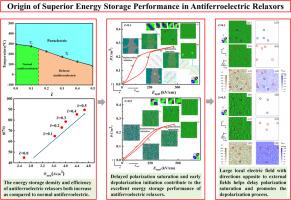Origin of superior energy storage performance in antiferroelectric relaxors
IF 8.3
1区 材料科学
Q1 MATERIALS SCIENCE, MULTIDISCIPLINARY
引用次数: 0
Abstract
Antiferroelectric relaxors (AFR) have attracted increasing attention for their potential to achieve large energy storage density and high efficiency simultaneously. However, the underlying mechanism behind their superior energy storage performance remains unclear. In this study, we establish a phase-field model of a doped antiferroelectric (AFE) systems by taking into account of the nanoscale compositional heterogeneity induced by random distribution of point defects as well as the associated local electric fields and local phase transition temperature variation. It is found that as the normal AFE transforms to AFR with defect concentration increasing, both the energy storage density and efficiency of the material increases, which is consistent with experimental results. The large energy storage density and high efficiency of AFR is ascribed to the “late” polarization saturation upon increasing external electric field and “early” depolarization initiation upon decreasing electric field due to the existence of larger local electric fields in directions nearly opposite to external fields in AFR materials, which leads to more elongated polarization-applied electric field loops. It is further found that although ferroelectric relaxors (FR) also have large local electric fields, the energy storage density is larger in AFR materials as compared to FR materials because the additional force to restore antiparallel polarization alignments inherent in AFR materials make the polarization saturation later and depolarization initiation earlier in AFR, leading to more elongated polarization-applied electric field loops. This study unravels the origin of high energy storage density of AFR and could provide theoretical guide to design high-performance energy storage materials.


反铁电弛豫器优异储能性能的来源
反铁电弛豫器(AFR)具有同时实现高能量储存密度和高效率的潜力,因而越来越受到关注。然而,其卓越储能性能背后的机理仍不清楚。在本研究中,我们建立了一个掺杂反铁电(AFE)系统的相场模型,该模型考虑了点缺陷随机分布引起的纳米级成分异质性以及相关的局部电场和局部相变温度变化。研究发现,当普通 AFE 转变为 AFR 时,随着缺陷浓度的增加,材料的储能密度和效率都会增加,这与实验结果一致。AFR 的高储能密度和高效率是由于在 AFR 材料中存在与外电场方向几乎相反的更大局部电场,从而导致更长的极化施加电场环路,在电场减小时 "晚 "极化饱和,"早 "去极化启动。研究进一步发现,虽然铁电弛豫器(FR)也具有较大的局部电场,但与 FR 材料相比,AFR 材料的能量存储密度更大,这是因为 AFR 材料固有的恢复反平行极化排列的附加力使得 AFR 材料的极化饱和更晚,去极化启动更早,从而导致更长的极化应用电场环路。这项研究揭示了 AFR 高储能密度的起源,可为设计高性能储能材料提供理论指导。
本文章由计算机程序翻译,如有差异,请以英文原文为准。
求助全文
约1分钟内获得全文
求助全文
来源期刊

Acta Materialia
工程技术-材料科学:综合
CiteScore
16.10
自引率
8.50%
发文量
801
审稿时长
53 days
期刊介绍:
Acta Materialia serves as a platform for publishing full-length, original papers and commissioned overviews that contribute to a profound understanding of the correlation between the processing, structure, and properties of inorganic materials. The journal seeks papers with high impact potential or those that significantly propel the field forward. The scope includes the atomic and molecular arrangements, chemical and electronic structures, and microstructure of materials, focusing on their mechanical or functional behavior across all length scales, including nanostructures.
 求助内容:
求助内容: 应助结果提醒方式:
应助结果提醒方式:


